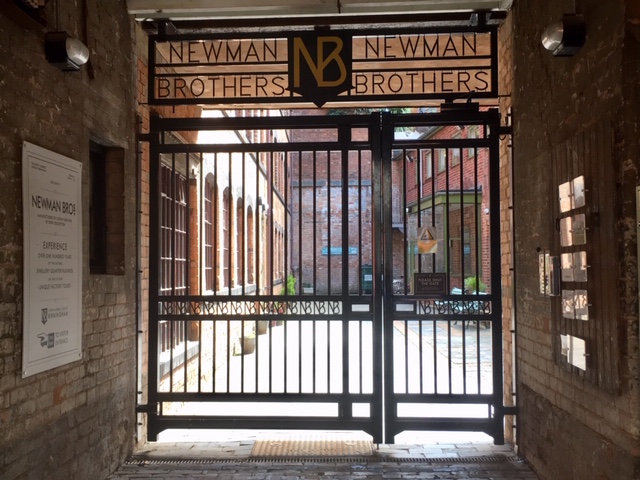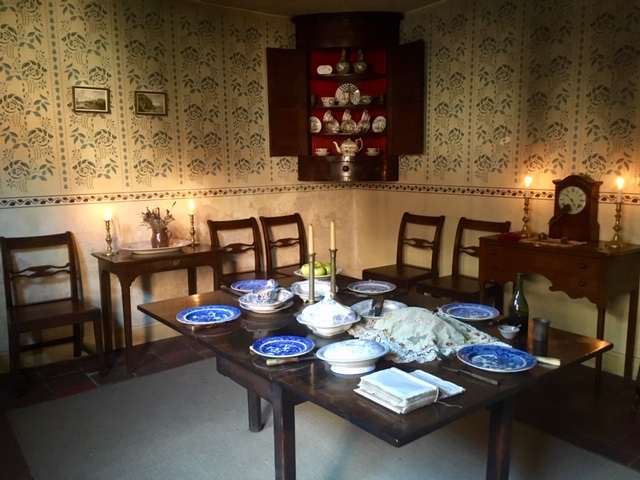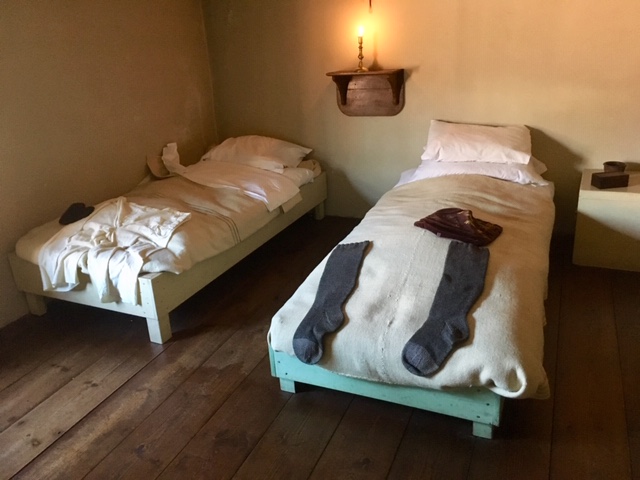The British Museum might have eight million items but that’s just too overwhelming for me. Instead I prefer small museums with a dedicated focus. That’s why the Coffin Works in Birmingham made it on to my UK bucket list. I recently visited the Coffin Works and another heritage attraction, the Back to Backs. Was it worth the bucket list entry?
Coffin Works
The Coffin Works museum is around 15 minutes walk from Birmingham New Street railway station. Along the way you’ll pass shiny new buildings, cranes and roadworks. All reflecting the huge changes to Birmingham’s landscape over the last few years.

From 1894 until 1998 the Newman Brothers manufactured coffin furniture from a factory on Fleet Street. After it closed the last owner, Joyce Green, fought to turn it into a museum. Her dream was realised and visitors can now discover the story of the company that once made coffin handles and decorations (not coffins!) for luminaries such as Winston Churchill and the Queen Mother.

Entrance to the Coffin Works is by guided tour only. The tour starts outside in the courtyard and takes in the stamp shop, warehouse, office and sewing room. Our guide, Cornellius, talked us through the different jobs carried out in each area and demonstrated how some of the machinery worked. One thing came across loud and clear; health and safety wasn’t paramount in those days!

What made the tour come alive was the stories of those who had worked at the Coffin Works. From Mr Ray, the gentleman who worked as the die sinker through to Diamond Lil who read tea leaves and worked in the plating shop.

In the warehouse we discovered shelves full of original stock. Cornellius explained that from the late 1960s all coffin furniture used in cremations had to be combustible so plastic fittings became commonplace. This was one factor in the eventual closure of the factory as the mark up on plastic fittings couldn’t compete with the metal furnishings.
The office was home to Joyce Green who joined the company, aged 18, as a secretary and eventually became the managing director and final owner. Much to the disdain of several male workers! Joyce had to contend with striking workers, a changing business climate and the eventual closure of the factory. Sadly she never got to see the opening of this museum but I’m sure she’d be happy with the results.

In the sewing room we learnt about shrouds and linings. A row of sewing machines lined the wall next to the windows, to ensure the seamstresses were able to work in good light.
However, pride of place went to a wedding dress made from shroud materials. Sheila, a seamstress, was too poor to buy her own wedding dress. Instead she created one out of stolen offcuts of lace and satin, coming in early to obtain the materials and then hiding them around her belly during the working day. Not many people get married in a shroud!

The tour ended in a small room with pictures and clippings from famous funerals. Although we’d only been onsite an hour or so it was an engaging and entertaining look at a business I knew nothing about, it definitely deserved its place on my bucket list.
Back to Backs
From the Coffin Works we hotfooted it across town to our next destination, the Back to Backs. These were a type of housing, built around a courtyard, once common in Birmingham and many other industrial towns in the 19th Century.

The houses at Inge Street are the last remaining courtyard of back to back houses in Birmingham. The National Trust now owns these properties and has renovated them to show what they might have looked like during different time periods. It makes a lovely change to see the National Trust preserving working class homes rather than stately houses.

Again, entry is by guided tour, bookable in advance, so you’ll need to be organised!
The tour starts outside, with a geography lesson. As I’m not particularly familiar with Birmingham it was helpful to get some bearings, even if I didn’t always know where the guide was referring to. We then walked through an alleyway into the courtyard and on into the houses.
Once inside we heard stories of the residents who lived there. We learnt about the lives of an 1840s Jewish toy maker, an 1870s glass eye maker and a 1930s lock maker. The houses are decorated as per the time periods. Possessions were minimal and space at a premium; be aware of low doorways and steep and winding staircases!

One of the most sobering rooms is the one which hasn’t been renovated. The other rooms all look as if they’d provide a level of comfort, commensurate with the times, but in the original room the ceilings, windows and walls are in very poor state of repair. We saw photographs of the houses shortly before renovation; I wouldn’t have wanted to live there!

The final house was the shop of George Saunders, a tailor, who came from St Kitts in 1958. It was interesting to learn about his life in Birmingham and the difficulties he faced as a Caribbean immigrant. The shop is kitted out in 1970s style, adorned with half finished suits and clothing patterns.
Outside in the courtyard are the shared toilets and laundry room. The laundry room contains a mangle; I remember using one of these after swimming lessons at secondary school! Indeed there were a few items on the tour which were familiar to me from my grandparents’ house.

After the tour finished we spent another 15 minutes in the National Trust traditional sweet shop trying to decide on some treats for the train journey home. There was just too much choice!
I’m happy to say that the Back to Backs tour perfectly complemented our earlier visit to the Coffin Works. I highly recommend both museums as they give a fantastic insight life in Birmingham over the last century.

My kids would love the coffin works! Glad to hear it was a worthy bucket list entry, always disappointing when something doesn’t quite feel like it deserved its place.
Absolutely fascinating. I really enjoyed reading about the coffin works, but actually the back to backs sound even more interesting. I think it’s vital to keep records of historical places like these – I wish there were more and would very much like a visit. I really enjoyed it when we went to see the old workhouse just outside Nottingham – similarly bringing history to life. And the York Castle Museum where we saw a mangle!